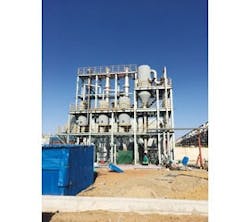China is actively encouraging the growth of coal-to-chemicals in a bid to reduce dependence on expensive imported energy sources. There are many such projects under construction or in planning in China, such as coal-to-gas, coal-to-olefins, coal-to-ammonia and coal-to-glycol. One such project is the Mengda Inner Mongolia project.
The owner of the project is China National Coal Group, which is the second-largest coal-chemical company in China. The project site is in Erdos, Inner Mongolia, located in the north of China. When completed in 2015, it will produce 500,000 tons of industrial-grade engineering plastics annually.
Coal-to-Chemical Facilities
Water shortages have been a problem for decades in Inner Mongolia. Increasing numbers of coal-to-chemical facilities are being built in Inner Mongolia in arid areas where rivers are under stress, underground aquifers are in decline and pollution is rampant. Considering the vast amounts of water needed for plant process and discharge and strict regulation of wastewater discharge, the biggest challenge for the Mengda project is to achieve its goal of zero liquid discharge (ZLD), meaning no contaminants from the manufacturing process will get into the groundwater system.
The inlet is the final water discharged by other water treatment systems and includes circulation discharge wastewater, desalted discharge wastewater and wastewater treatment plant discharge water. The ZLD process concentrates the 2,425-gal-per-minute (gpm) liquid flow with about 2,000 mg/L total dissolved solids (TDS) into a solid and makes the treated water reusable. The final treated clean water’s TDS level is less than 100 mg/L. The solids then are transferred to a landfill.
In general, a traditional ZLD process uses thermal treatment, which is always a large investment with a high operation cost, which can be a burden to the client; thus, balancing green with profit is another challenge faced by this project.
Breaking Down the ZLD Process
In China, the evaporation operation cost is about $30 for every thousand gallons of water evaporated, so the ZLD system design attempts to make the concentration as high as possible before evaporation to make the process less expensive. The process combines membrane and thermal treatment processes. With a membrane process, it can recover about 98% of water from system, leaving only 2% to evaporation, while the operation cost of membrane is one-tenth of evaporation. This can make the ZLD process affordable. The whole process includes three basic steps: softening, membrane concentration, and evaporation and crystallization.
Softening is a pretreatment that lowers the risk of scaling on the membrane. By adding lime, most hardness ions such as calcium and magnesium are removed. Water with low scale-forming dissolved solids has a higher recovery rate.
Membrane concentration is the most important step; it uses reverse osmosis (RO) to concentrate TDS as much as possible prior to thermal concentration with three stages: normal RO, anti-fouling RO and high-press vibration RO. The feedwater TDS to normal RO is about 2,000 mg/L. This stage concentrates the water to about 6,000 mg/L TDS. The anti-fouling RO can concentrate the water into about 20,000 mg/L TDS, but the concentration of scale-forming ions and osmotic pressure limit RO recovery, and after the anti-fouling RO, traditional-structure RO cannot be used to further concentrate TDS more than 20,000 mg/L.
Most ZLD projects will stop there, then use thermal treatment for further treatment—only recovering 90% of water, with a feedwater flow of about 242 gpm. The Mengda project applies the Vibratory Shear Enhanced Processing (VSEP) system for further concentration. The vibration structure of VSEP can concentrate the wastewater that normal RO cannot treat by generating a shear force on the membrane that stops foulants from sticking to the surface, allowing a higher recovery. The VSEP system can concentrate wastewater to 60,000 mg/L TDS, leaving 45 gpm to the evaporation process, so the recovery can be 98%. The operation cost savings are about $3 million per year.
Inner Mongolia is a place of plentiful sunshine and land, and the Mengda project uses a solar pond for final evaporation and solids-liquids separation. An HDPE impermeable layer prevents any liquid from seeping into groundwater. The final solids are regularly transferred to a landfill for disposal.
The Mengda project is one of the largest ZLD coal-chemical projects currently in progress in China.
Download: Here


